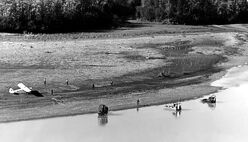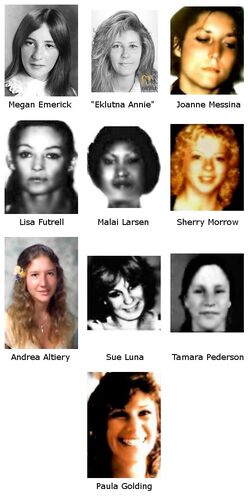"You can't rape a prostitute, can you?"
Robert "Bob" Christian Hansen (not to be confused with American spy Robert Hanssen) was an Alaskan serial killer and rapist who abducted prostitutes and hunted them in the wilderness in the early 1980s.
Background
Hansen was born in Estherville, Iowa, in 1939. His parents were Christian, a Danish immigrant, and Edna Hansen. His father, with whom he had a difficult relationship, was very strict and often made him work long hours at the family-owned bakery. During his childhood, he was often bullied for his stutter and severe acne. In school, he had no close friends. After graduating high school in 1957, he enlisted in the U.S. Army Reserve, where he became a skilled marksman, serving one weekend a month and working at the bakery the rest of the time, sometimes volunteering as an assistant drill sergeant at the police academy in the town of Pocahontas. In 1960, he fell in love with and married a local girl. On December 7 the same year, he burned down the school bus garage of the local high school, but was caught when a friend turned him in. During his three-year sentence in prison, he divorced. After only 20 months, Hansen was paroled even though he had been diagnosed as having an "infantile personality". In 1963, he remarried a woman with whom he had two children. In 1967, after several jail sentences for petty theft, he moved to Anchorage, Alaska with his family. Well-liked by people who knew him, he became an avid hunter, breaking several hunting records (his records were nullified after his conviction). His weapons of choice were rifles or bow and arrow. The year after his last record breaking, he was convicted of raping a prostitute and attempting to rape a housewife, but only served six months in prison. In 1977, he was imprisoned again for stealing a chainsaw and was diagnosed with bipolar disorder. He was prescribed lithium, but wasn't required by law to actually take it. He was released after only a year. In the early 1980s, he reported a burglary on his home, which he had actually staged. With the money he got from the insurance company, he opened up a bakery of his own and established himself as a well-liked family man. In January 1982, he bought himself a Piper Super Cub bush plane, even though he had been denied a license due to his medication.
Killings, Arrest and Incarceration

Search at the Knik River where several Hansen's victims were found.
During later questioning, Hansen claimed that starting in 1973, after finishing his rape sentence, he became a serial rapist, picking up prostitutes from Anchorage's tenderloin district and taking them by his bush plane to the wilderness, where he would rape and torture them. He later claimed that the ones who complied, he would return to Anchorage alive, and those who didn't, he would kill. From 1973 to 1983, he abducted and raped at least 30 women that way and let them go. At least 17 women picked up during the years 1980-1983 were less fortunate. After raping them, he released them in the woods and hunted them with a hunting rifle. His crimes first became known in 1982, when the body of exotic dancer Sherry Morrow was found near the Knik River by two off-duty police officers. It took two weeks to identify her. A spent .223 shell casing was found in the dirt near the body. Two years prior to that, two other women had been found in similar circumstances. The first was found by construction workers near Eklutna Road and has never been identified; the investigating officer nicknamed her "Eklutna Annie". The second was topless dancer Joanne Messina.

Hansen's .223 caliber Ruger Mini-14.
On June 13, 1983, a young prostitute named Cindy Paulson was spotted with a handcuff on her wrist by a trucker. He gave her a ride to a motel, where she waited for her pimp, and called the police. When an Anchorage Police Officer, Gregg Baker, arrived, Paulson told him how a man (Hansen) had offered her $200 for oral sex, handcuffed her and forced her at gunpoint into his car. He then drove her to his house (Hansen's wife and children were vacationing in Europe at the time) and brutally raped and tortured her. Afterwards, he drove her to an airport and put her in his bush plane, presumably to take her to the wilderness and kill her as well. While he was loading it with supplies, she fled. Paulson made a formal statement to the police and not only identified the make and color of the plane, but also remembered its tail number. Hansen turned out to be the owner and was identified by Paulson as her attacker, but two of Hansen's friends gave him a false alibi for the night of the attack, so no formal charges were filed. On September 2, the body of another victim of Hansen, Paula Golding, turned up and the case was brought up again. The Alaskan investigators began looking into Hansen again and contacted the FBI, who sent in their profiler, John Douglas (some sources say it was Roy Hazelwood). He profiled the killer as having low self-esteem, a history of rejection by women, and being an experienced hunter. He also correctly predicted that he would take souvenirs from his victims and would have a stutter.
When the two men who gave Hansen an alibi for the night he attacked Cindy Paulson confessed that they had been lying, the investigators focused on him. They brought him in for questioning while executing search warrants on his house, plane and cars. In his house, they found a collection of weapons, including the .223 Ruger Mini-14 he had used to commit his murders, IDs and jewelry taken from his victims and an aviation map with several marked locations. When an FBI forensic lab matched the shell casings found near the victims to the Mini-14 found in Hansen's house, he made a plea bargain. He was charged with the four murders whose victims had been found and with the abduction and rape of Cindy Paulson and agreed to confess to all of them, give details about his victims and show the burial sites marked on his map in exchange for serving his sentence in a federal prison and avoiding media publicity. He showed the police 17 of his burial sites, but refused to help them with the other four; it has been theorized that he wouldn't confess to killing them because they were neither prostitutes nor strippers and he couldn't justify their murders to himself. The victims that were found were exhumed and returned to their families. On February 18, 1984, Hansen was convicted of murder and sentenced to life in prison plus 461 years. He was initially incarcerated at the United States Penitentiary in Lewisburg, Pennsylvania, before being moved back to Alaska and jailed at Lemon Creek Correctional Center, then Spring Creek Correctional Center. On May 11, 2014, he was moved to the Anchorage Correctional Center to receive medical attention for undisclosed, lingering health conditions. Hansen died on August 21 of the same year at Alaska Regional Hospital due to undisclosed health conditions. He had a "do not resuscitate" order on his file.
Modus Operandi
Hansen targeted prostitutes and topless dancers. After soliciting them, he would abduct them and take them to a meat shack by bush plane. He later stated that he would let them live if they submitted to his sexual fantasies. The ones who didn't, he would rape anyway, strip naked and then set loose in the wilderness and hunt with a .223 hunting rifle. After finally killing them, he would take pieces of jewelry from them as souvenirs and bury the bodies in the area, marking the burial sites on a map.
Known Victims

Several victims of Robert Hansen.
- Unspecified dates in 1973 to 1979: 30+ unnamed women (all raped, but not killed)
- July 7, 1973 (disappeared): Megan Emerick, 17
- Unspecified date in 1975: Mary Thill, 23
- 1980:
- June 28 (disappeared): Roxanne Eastland, 24
- July (disappeared): Joanne Messina
- September 6 (disappeared): Lisa Futrell, 41 (her body was found on May 9, 1984)
- Unspecified date (found): "Eklutna Annie" (pseudonym; unidentified)
- 1981:
- November 17 (disappeared): Sherry Morrow, 24 (shot three times; her body was found on September 12, 1982)
- Unspecified date (disappeared): Andrea "Fish" Altiery
- May 26, 1982 (disappeared): Sue Luna, 23
- 1983:
- April 25 (disappeared): Paula Golding, 17 (her body was found on September 2)
- June 13: Cindy Paulson, 17 (attempted; abducted, raped and tortured; escaped)
- 1984:
- April 25 (found): DeLynn "Sugar" Frey
- April 26 (found):
- Teresa Watson
- Angela Feddern, 24
- April 29 (found): Tami Pederson, 19
- Other victims, all killed between 1980 and 1983:
- Ceilia "Beth" Van Zanten, 17
- Mary Thill, 23
- Malai Larsen, 28
- An unidentified victim
- Angela Feddern, 24
- Teresa Watson
On Criminal Minds
Hansen was first mentioned by name in Exit Wounds when Hotch says the FBI's Alaska field office haven't handled a serial killer investigation since his case, though they weren't technically involved; the local police contacted John Douglas, who made an offender profile. The FBI were involved in the forensic investigation, but it was their crime lab in Washington that handled that. The FBI and the Alaskan authorities had also cooperated in the case of Thomas Richard Bunday, who killed five women and then himself when a warrant for his arrest was issued. The Footpath Killer appears to have been partially based on Hansen in the sense that both killed their victims by shooting them and were correctly profiled to have been speaking with a stutter. Hansen's case may also have been some inspiration for The Mulford Family, who would also abduct people and hunt them in the wilderness like animals, though the cases are only similar in that aspect. Otherwise, the cases were completely different, for:
- Hansen raped his victims before hunting and killing them, but the Mulfords were not sexually motivated,
- Hansen targeted prostitutes and the Mulfords killed random motorists,
- The Mulfords hunted their victims with compound bows and Hansen used rifles (though some sources state that he also used a crossbow), and
- Hansen worked alone and the Mulfords hunted as a pair.
Sources
- Wikipedia's article about Hansen
- Radford University's summary of Hansen's life
- ExploreNorth.com article about Hansen
- About.com article about Hansen
- NBC News article about Hansen's death
- Evil Beyond Belief (2009)
- The Killer Book of Serial Killers (2009)
